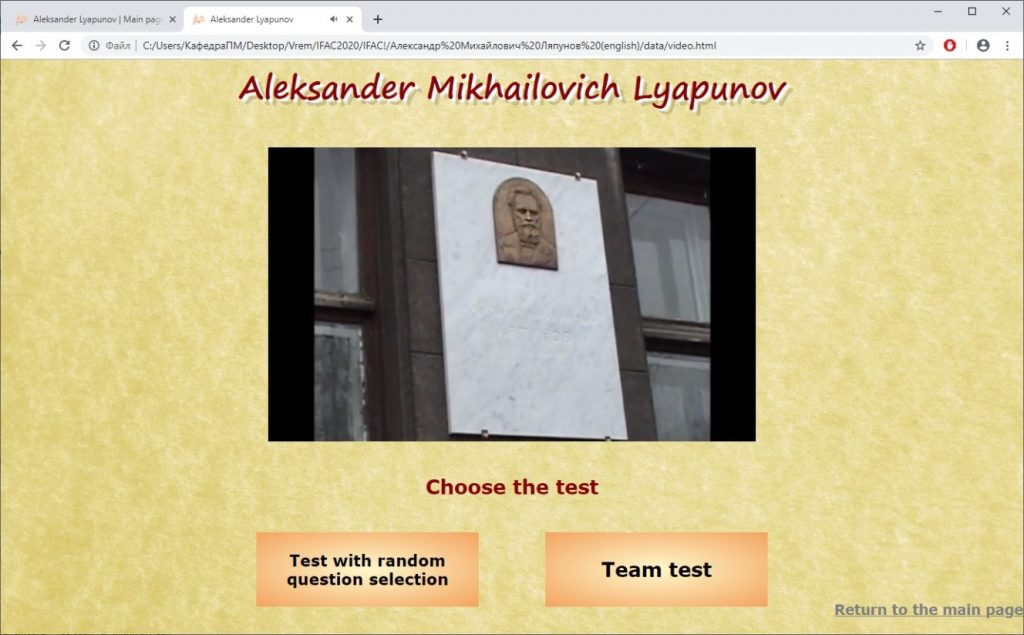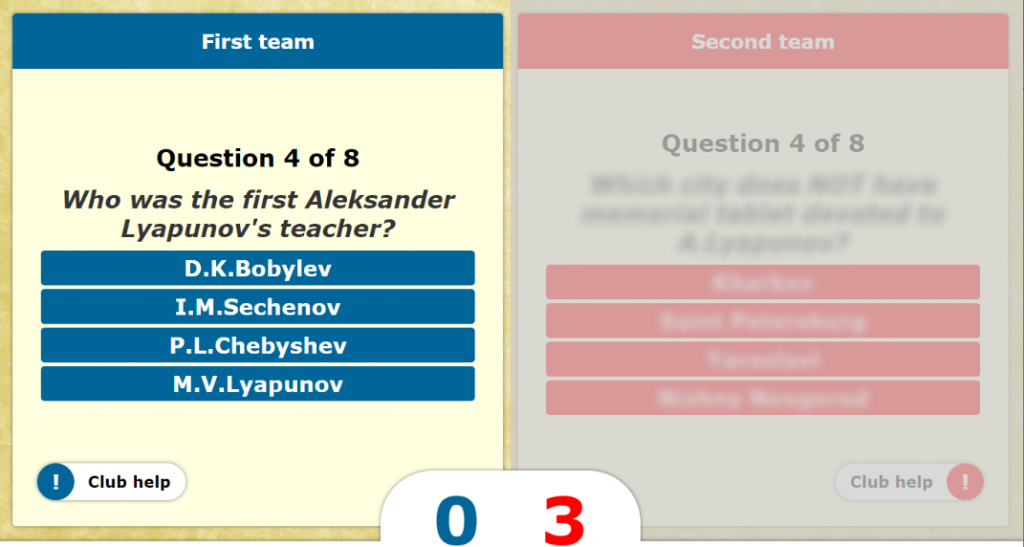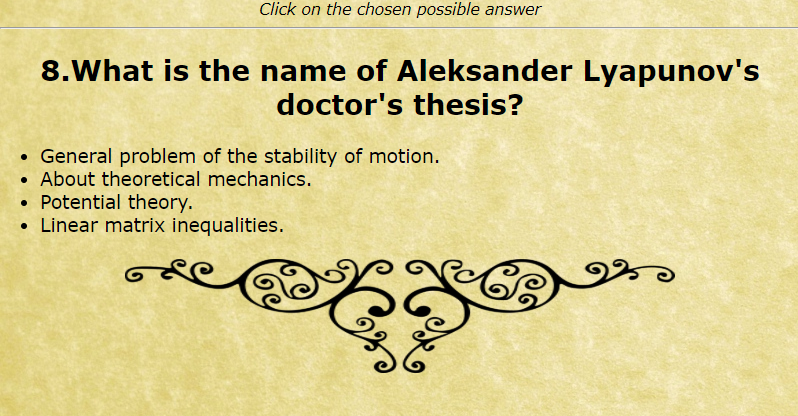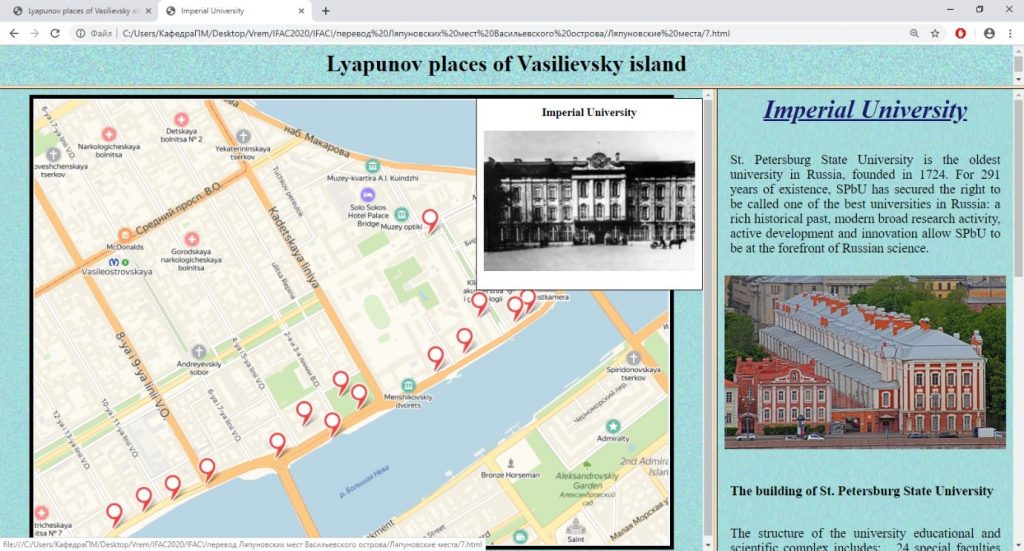- Introduction
In order to teach students a respectful attitude towards the profession, it is important to constantly draw their attention to those individuals who have significant achievements in this profession. Unfortunately, the public assessment of the role of science is currently rather low. The history of science, people of science are often little known. In order to solve this problem, widespread propaganda and popularization of scientific activity is needed [1, p. 97].
Many researchers stressed the need for students to study the history of science seriously and carefully. Here is a quote from the article by McComas W.F., Clough M.P., Almazroa H.: “Science has a pervasive but often subtle, impact on virtually every aspect of modern life…. However, despite this enormous effect, few individuals even have an elementary understanding how the scientific enterprise operates. This lack of understanding is potentially harmful, particularly in societies where citizens have a voice in science funding decisions” [2].
Stephen G. Brush from the University of Maryland devoted his paper to the issue of improving the general understanding of science among our citizens [3]. He thinks that “the current revival of concern for the quality and effectiveness of education includes discussion of issues such as motivating students to learn subjects they regard as difficult, changing the public perception of scientists, encouraging informed participation in decisions about the uses of technology, and conveying an appreciation of science as part of culture. To achieve these goals, educators have often recommended the use of the history of science.”
Studying the history of any science is important both from a cognitive and moral and ethical points of view. This idea is not new, but the topic has been relevant at all times.
Jan Amos Komensky, the great Czech teacher of the Middle Ages, argued that “the study of the history of great discoveries must constantly accompany the main activities” since “this is a very pleasant food for the minds” [4, p. 63, 82].
Currently, there are a very large number of approaches how to communicate historical material to students, and a great variety of information resources that students can use.
It is possible to classify ways of introducing students to historical materials by the following pattern: use of modern computer tools or use of traditional approaches. This is the most widespread classification scheme (Fig. 1).

Figure 1. Classification of forms of studying the history of science in the framework of the course «Theory of automatic control»
In addition, at present electronic sources of information are divided depending on the access to them: local materials or resources that are publicly available.
This article will focus on how to include historical sections in the structure of lessons on Control Theory, and how to use an interdisciplinary approach. Let us start with the traditional methods.
- 2. Traditional approaches
Let us consider how historical aspects are included and studied in the educational process at the Department of Applied Mathematics of Arzamas Polytechnic Institute of R.E. Alekseev Nizhny Novgorod State Technical University. Since this process is multifaceted, and the size of the article does not allow covering all aspects, let us focus on the life and work of one great scientist, the founder of the theory of sustainability, academician Alexander Mikhailovich Lyapunov, and how students of our university are introduced to the information about him.
The students are familiar with such concepts as Lyapunov’s theorem, Lyapunov’s inequality, Lyapunov stability, Lyapunov’s function and many others. But do they all know that streets and lanes are named after him, that memorial plaques and monuments are established in his memory in the cities where he once lived and worked: in St. Petersburg, Kharkov, Odessa, Nizhny Novgorod? Few of them know that a third of his life was spent in the Volga region, and more precisely in Nizhny Novgorod and estates located on the territory of the modern Nizhny Novgorod region. Lyapunov’s achievements are a part of history to be proud of, and the study of the history of the native land is one of the important directions in personality development.
At the Department of Applied Mathematics, it has become a long tradition to study life and honor the memory of the great Russian scientist A.M. Lyapunov, to increase awareness of his activities. It was at the Department of Applied Mathematics that Lyapunov was elected a staff academician of the Russian Imperial Academy of Sciences at the very beginning of the 20th century. But the representatives of our department not only this have in common with the mathematician. The main thing is that many new developments of lecturers and graduate students of our department are based on A.M. Lyapunov’s achievements, i.e. his works are actively used in current scientific work [5−9].
In 2007, a memorial plaque was opened on the building of the former gymnasium in Nizhny Novgorod, where he studied. It was done thanks to the efforts of the initiative group of teachers and students of the Department of Applied Mathematics of Arzamas Polytechnic Institute of R.E. Alekseev Nizhny Novgorod State Technical University.
For fifteen years the teachers have been conducting serious archival research, and trying to arrange the collected materials in order to introduce their students to them. There are a lot of ways of presenting the material, but are they all equally effective?
A small video clip was created in order to introduce students to A.M. Lyapunov’s life and achievements (Fig. 2). It is devoted to those areas of science where Lyapunov’s contribution was particularly great — the theory of stability, the theory of probability, the theory of potential, etc., as well as to the life of this person. The video clip represents the main stages of A.M. Lyapunov’s life including childhood, youth; work at Kharkov Imperial University and Kharkov Polytechnic Institute, Novorossiysk University and Russian Academy of Sciences. This video clip includes generally known photos as well as unique pictures taken by the authors during trips to Odessa, Kharkov, St. Petersburg and Nizhny Novgorod. Background music of the video clip is composed by Lyapunov’s contemporary P.I. Chaikovskiy [10].

Figure 2. The start page
The video clip will remain just a source of information, and will not be a learning tool until some testing tools are connected to it. In our case, a command test was developed to control and reinforce the material, which gives the opportunity for two teams to be tested at once [11].

Figure 3. The test selection
A distinctive feature of the system is that its use is designed for only 12-15 minutes (a video lasts five minutes and testing takes about ten minutes). In other words, its inclusion in the educational process does not require any major adjustment of curricula and programs. It is especially effective to use at lectures, when not only the video, but also the testing procedure is projected onto the big screen.

Figure 4. The main page of testing

Figure 5. Team test “ Alexander M. Lyapunov ”
Any organization of lessons including elements of public actions contributes to a more responsible work of students. As shown by trial operation, the use of team-based public tests in the educational process makes classes more lively and interesting. The video and testing program “Alexander Mikhailovich Lyapunov” is intended for use in introductory lectures in courses Management Theory and Linear Matrix Equations and Inequalities. This method of introducing historical material to students has turned out to be quite effective.
Despite the fact that designing both the video clip and the testing program was based on the latest information technologies, this approach can rightly be attributed to the traditional ones from the point of view of conducting lectures.
Now, let us consider the monograph “Alexander Mikhailovich Lyapunov: years of accomplishments”, published by Intercontact Publishing House in 2019 (fig. 6) [12].
The book reflects the years spent by A.M. Lyapunov in St. Petersburg, Kharkov and Odessa. It consists of essays popularly presenting the history of this person’s life. The monograph is intended for historians of science and teachers of Russian universities. It can be used as a source of versatile information about the work of educational institutions and education of the second half of the XIX — early XX centuries.

Figure 6. The monograph cover
It describes in detail the educational process at the physics-mathematical departments of Russian universities, the work of mathematical societies, the scientific conferences and congresses of scientists which were held on a large scale in Russia and Europe. The edition has 402 photographs, diagrams, and copies of documents. The book presents numerous photographs, both of Alexander Mikhailovich and of his family members, friends and colleagues. In addition, you can find the pictures of those places where the scientist happened to live, work, relax. This visual material helps to communicate to the reader as much reliable evidence of that long-gone era as possible.
But are modern students going to read a book of 468 pages? Hardly. This monograph is intended more for teachers and researchers. So, connecting historical references to the main learning tools seems to be a more acceptable approach.
Teachers began to include historical references in both electronic and traditional paper-based learning tools. For example, an entire chapter in manual “Matrix Equations and Inequalities” is devoted to the founders of linear matrix inequalities, among which Alexander Mikhailovich Lyapunov has an acknowledged place [13].
Unfortunately, connecting a historical chapter to the learning tool, or adding a block with historical background to an e-learning tool have not produced any desired results as students most often skip or flip through such pages.
Nowadays in the digital world there is a need to revisit the content and the methodology of teaching different subjects. It is necessary to rethink pedagogy for a digital age [14].
From the pedagogical point of view, internal effort is a key factor, without it a student is not able to work effectively. It is necessary to motivate students, i.e. formulate educational tasks in such a way that students have to learn the material, in this case related to the history of science or biographies of prominent scientists. It is rather difficult to introduce historical aspects within the course of Management Theory, at least for the lack of time in classroom studies. In this case, the interdisciplinary approach may be more useful.
- Alternative approaches
For example, it is possible to effectively combine the study of historical references with foreign languages learning.
In our case in English lessons, students watch a 5-minute video clip about academician A.M. Lyapunov in Russian, and then do a team public test with questions and answers in English, which are projected onto the large screen in the class. Other forms are also possible, for example to demonstrate a clip in English, and then do testing in Russian. Both clips and tests can be presented in English (Fig. 7, 8). It depends on the students’ level of the foreign language.
In such disciplines as Information Technology, Computer Learning Technologies, Computer Technologies in Science and Education, students learn to create Web resources, tests, interactive schemes and maps. Except for the knowledge and use of markup and programming languages, it involves the use of some content, i.e. of the material that allows to create a ready-to-use software product, and not just a shell or template.

Figure 7. The Examples of Web-page

Figure 8. The test result
We offer our students to use biographical materials. Students carry out simple projects directly in the classroom, and the most time-consuming ones while doing term papers. Genealogical scheme of the Lyapunov family (Fig. 9) and interactive diagram of family ties between the Lyapunovs and the Sechenovs can be shown as examples.

Figure 9. Part of genealogical scheme of the Lyapunov family
Students master the ability to develop testing programs with a random selection of questions from the database. When compiling questions and answer options for them, they are asked to use a selection of biographies “Linear matrix inequalities in faces”. The task is formulated as follows: “Develop test questions about one of the founders of the theory of linear matrix inequalities in accordance with your variant:
Variant 1
A.M. Lyapunov, make 7 questions for the base, ask the person tested 5 questions from them.
Variant 2
A.I. Lurie, make 6 questions for the base, ask the person tested 4 questions from them.
Variant 3
V.A. Yakubovich, make 7 questions for the base, ask the person tested 4 questions from them.
Variant 4
- Kalman, make 7 questions for the base, ask the person tested 5 questions from them.
Variant 5
E.S. Pyatnitsky, make 8 questions for the base, ask the person tested 5 questions from them.
Variant 6
Ya.Z. Tsypkin, make 7 questions for the base, ask the person tested 5 questions from them.
Modify a typical testing program, debug the software product [15].
Students create tests using the JavaScript language, but in addition to programming, each student is introduced to the activities of one of the outstanding scientists.
A typical example of such projects is also the interactive map “Lyapunov’s Places of Vasilyevsky Island”, which shows the buildings in which A.M. Lyapunov lived or worked. When a cursor is placed on the pointer, a photo of the building appears, and the information page appears upon clicking (Fig. 10).
Active teaching methods are involved in all the cases mentioned. Students are given some tasks, and in order to do them successfully, they get acquainted with material on the history of science. While developing such products, students primarily practice using information technologies (HTML and JavaScript, CSS web page design tool), but they also learn the biographies of great scientists, and they get this information in an unobtrusive way.
One issue in the application of these approaches is to be mentioned –there should be a group of like-minded teachers of different disciplines. They must be convinced that this method of introducing students to historical information is effective, and are ready to include it in their courses. There is such a team at Arzamas Polytechnic Institute of R.E. Alekseev Nizhny Novgorod State Technical University.

Figure 10. Interactive map of Vasilievsky island of St. Petersburg
- Conclusions
Possible ways to include historical materials in the educational process at university have been examined on the example of introducing students to the activity and biography of an outstanding scientist in the field of automatic control, Alexander Mikhailovich Lyapunov.
Traditional paper-based approaches do not always satisfy modern students. The old structures are no more able to respond to the new challenges [16]. Such work only partly solves the tasks of promoting and popularization.
Electronic learning tools seem to be more preferable. Video clips with testing have proved to be successful. There is a lot of work to be done − this is the study of historical references as part of the interdisciplinary approach with the use of active teaching methods.
The proposed methods allow students to get acquainted only with the names, portraits and curriculum vitae of prominent scientists and, of course, cannot replace a separate specialized course History of Management Theory. But, nevertheless, they play a positive role in terms of enhancing students’ motivation, educating and expanding their horizons.
Acknowledgements
The authors would like to thank A. Dyatlov, N. Churivova, N. Sludova and I. Capitanova for help with e-learning tools.
References
1. Pakshina N, 2005. The role of promoting scientific knowledge in modern reality. Fundamental research, 10, pp 97-98.2. McComas W, Clough M. and Almazroa H, 1998. The Role and Character of the Nature of Science in Science Education. In: McComas W.F. (eds) The Nature of Science in Science Education. Science & Technology Education Library, Springer, Dordrecht. Vol 5. pp 3-39.
3. Brush S. 1989. History of Science and Science Education. Interchange, 20(2), 60–70. doi: https://doi.org/10.1007/BF01807048.
4. Komensky Y, 1982. Selected pedagogical works. Moscow: Pedagogy, in 2 volumes. Vol. 2.
5. Pakshin P, Pozdyayev V, 2005. Existence Criterion Of The Common Quadratic Lyapunov Function For A Set Of Linear Second-Order Systems. Journal of Computer and Systems Sciences International., 44 (4), 519-524.
6. Emelianova J, Pakshin P, Gałkowski K and Rogers E, 2014 Vector Lyapunov Function Based Stability Of A Class Of Applications Relevant 2d Nonlinear Systems. IFAC-PapersOnline., 8247-8252. doi: 10.1016/j.ifacol.2017.08.799.
7. Emelianova J, 2017. Vector Lyapunov function method for weak stability analysis of discrete repetitive processes, Scientific and Technical Volga region Bulletin, 6, pp.187-189. doi: 10.24153/2079-5920-2017-7-6-187-189.
8. Pakshin P, Emelianova J, Ga lkowski K, Rogers E, 2017. Stability analysis of 2D Roesser systems via vector Lyapunov. IFAC-PapersOnline. Vol. 50. Issue 1. pp. 4194-4199. doi: 10.1016/j.ifacol.2017.08.799.
9. Emelianova J, 2018. Stabilization of nonlinear Fornasini-Machesini systems. Automation and Remote Control. Vol. 79. No 10. pp. 1903-1911. doi: 10.1134/S0005117918100132.
10. Pakshina N, Emelianov М, Pravdina M, 2016. Using clips in learning process. International Journal Of Applied And Fundamental Research, 1, 140-143. [Online]. Available at www.science-sd.com/463-24979. Accessed 14 June 2020.
11. Pakshina N, Pravdina M, Koposov A, Pakshin P, 2017. Team Public Testing in Classroom Studies on Automatic Control Theory. IFAC-PapersOnline. Vol. 50-1, 13468−1347. doi: 10.1016/j.ifacol.2017.08.2318.
12. Pakshina N, 2019. Alexandr Mikhajlovich Lyapunov: years of accomplishments. Arzamas-Sarov, Intercontakt, Russia.
13. Emelianova J, Pakshin P and Pakshina N, 2013. Matrix Equations and Inequalities: Study guide, R.E. Alekseev NNSTU Press, Nizhny Novgorod, Russia.
14. Benedek A, Vámos T, Bars R and Sik D, 2019. Open Content Development Applied in Learning Systems and Control. In: Proc. of the 18th European Control Conference (ECC) Napoli, Italy, June 25-28, pp 3059-3064.
15. Pakshina N, Emelianova J, 2014. Fundamentals of tests and testing programs: Study guide, Nizhny Novgorod, R.E. Alekseev NNSTU Press, Russia.
16. Nore H, 2015. Re-Contextualizing Vocational Didactics in Norwegian Vocational Education and Training. Int. Journal for Research in Vocational Education and Training (IJRVET). Vol. 2, No. 3 (Special Issue). pp 182-194, doi: 10.13152/IJRVET.2.3.4.
